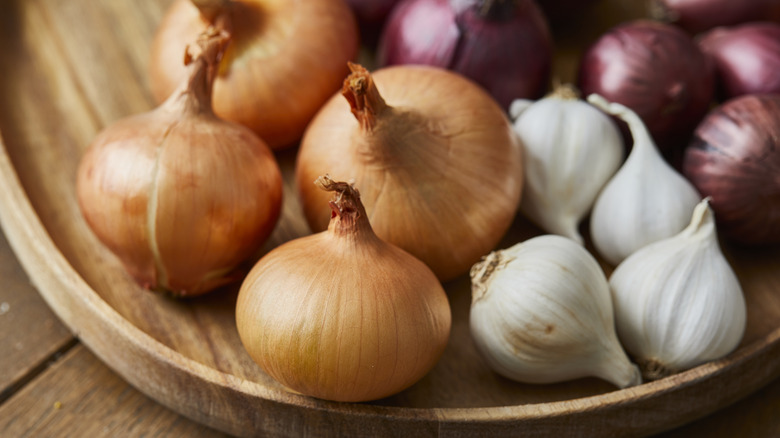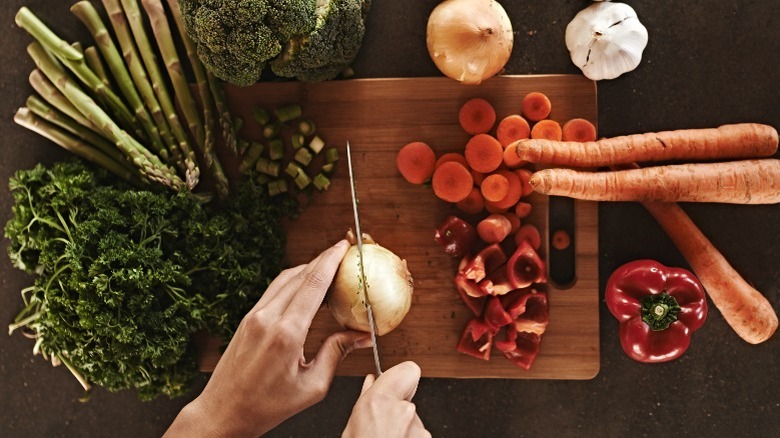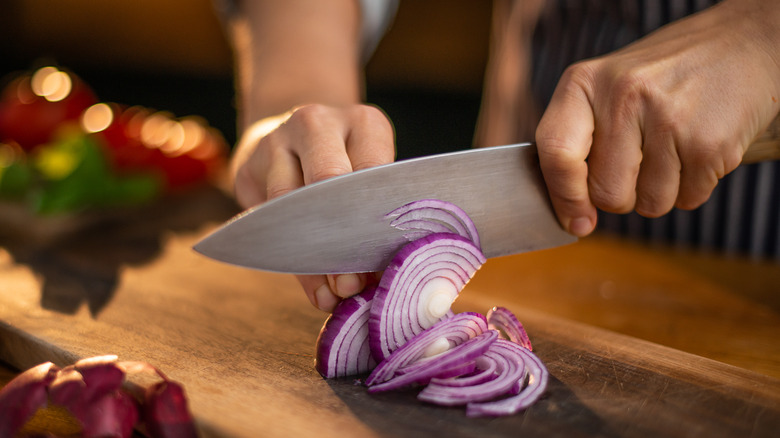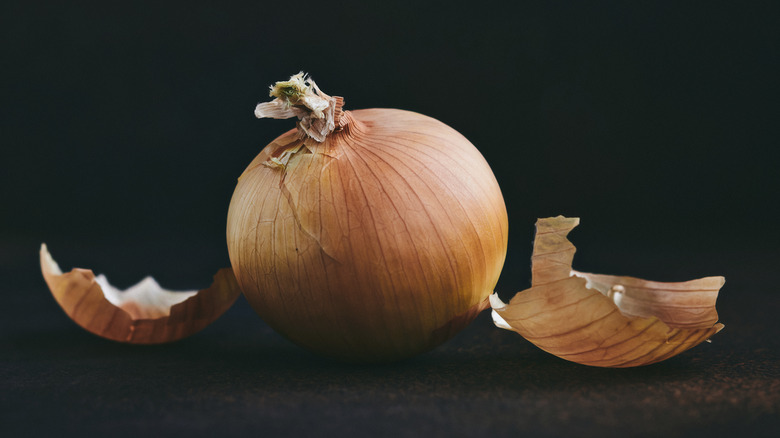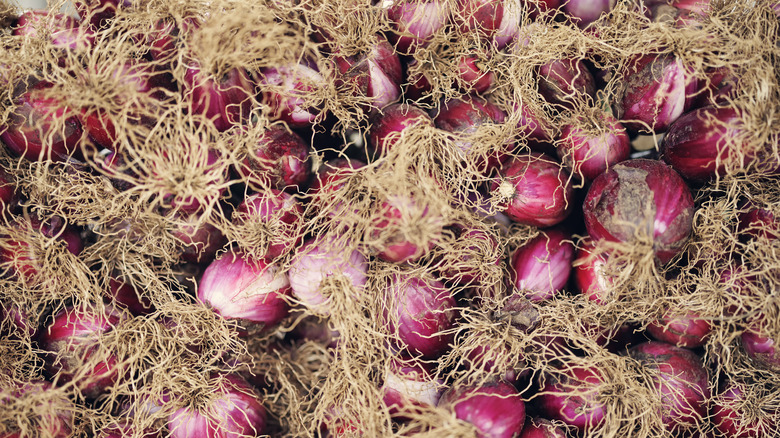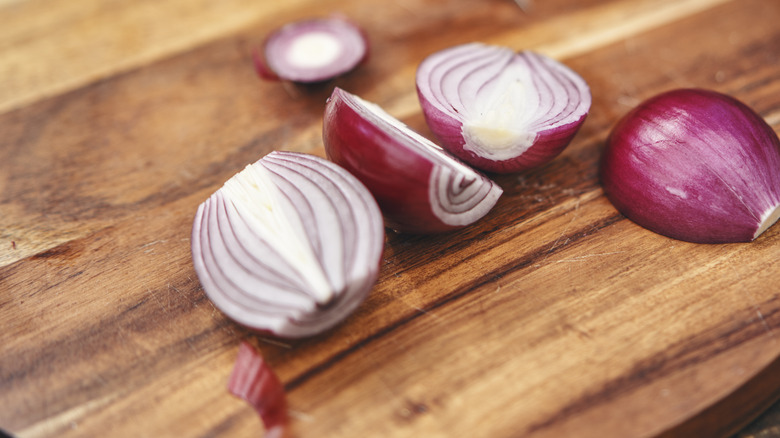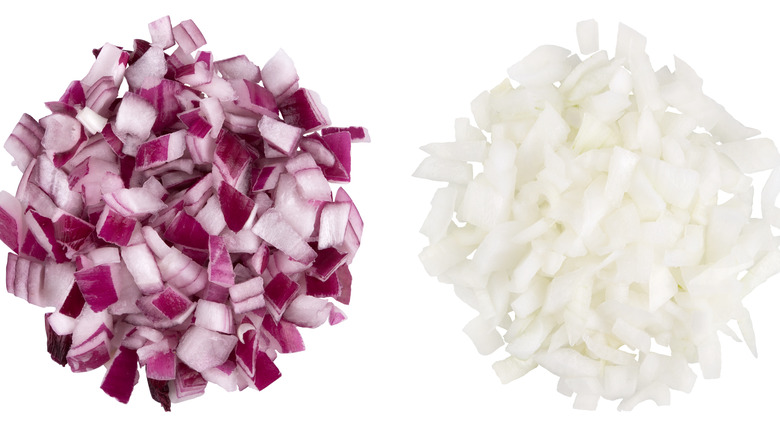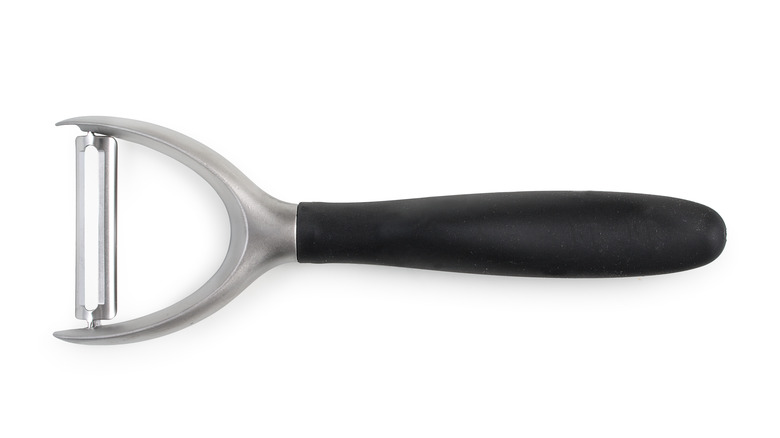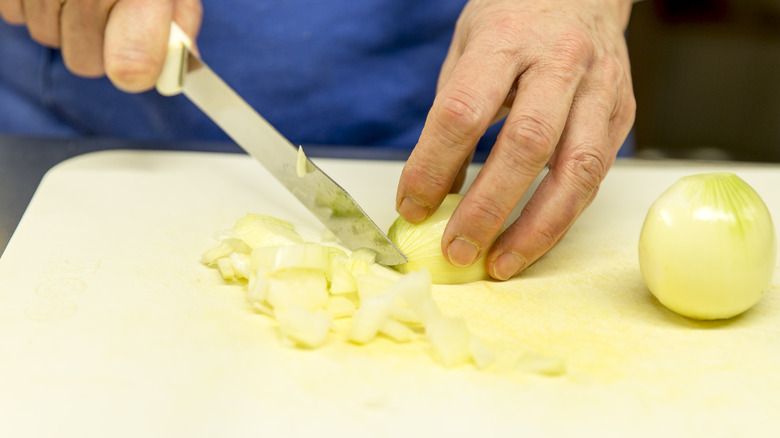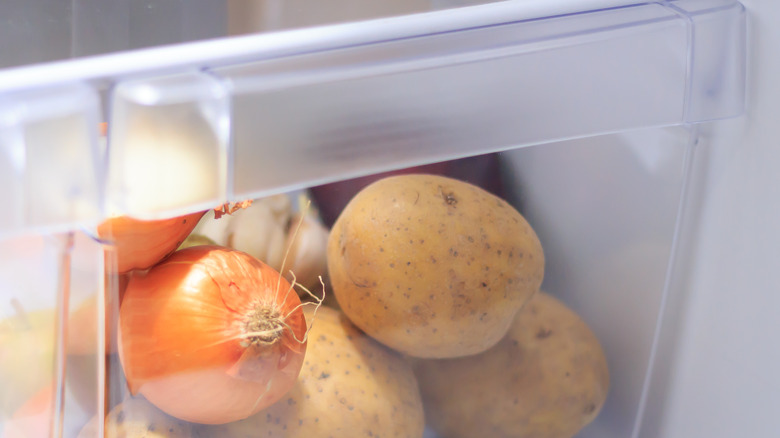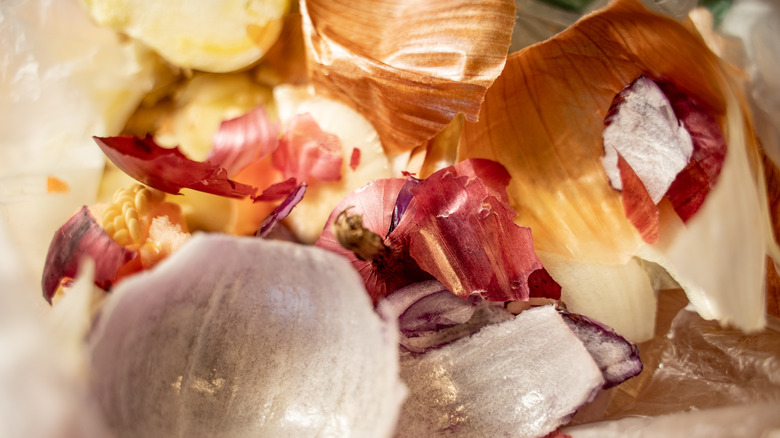11 Tips You Need When Cutting Onions
Onions, members of the allium family, are some of the world's oldest cultivated plants. The number of onion types we're most familiar with barely scratches the surface of the variety of close and distant relatives on the onion family tree. While they are short on nutritional value, onions are a beautifully nuanced and versatile ingredient. They can be harsh or gentle, bringing heat and bitterness to sauces, burgers, hotdogs, and more in their raw form, or they can be sweet and silky in soups or as an ice cream flavor, should you wish to go that route.
For all of their versatility, many people have difficulty with onions. It could be the acridness that stings their eyes and makes their noses run. They could struggle with peeling them or simply slicing them in a way that makes sense. In teaching new professional cooks and home cooks, few things challenge the students as much as cutting an onion. Learning what to do when cutting an onion is the first step to unlocking all the wondrous things that onions can do, so let's get on with that important first step.
1. Work organized
You're home from the market and ready to make a triple batch of French onion soup for your friends coming over this weekend. Reading the recipe, you need six onions cut in half and thinly sliced. That's when panic sets in — this could take an hour!
Walk into a professional kitchen when the cooks need 24 thinly sliced onions, and you'll see them go about it in a systematic, organized way optimized for speed and efficiency because they can't spend the same amount of time as you to accomplish the task.
Start by understanding your steps. First, you need to cut the end off the onion. Then, cut the onion in half to make peeling more manageable. After that, you'll peel it and slice it. Line your onions up and perform all of the same actions at once. Cut all six ends off, halve them, and peel them all, and you'll end up with six onions that are ready to slice without having to stop and perform different tasks for each onion. This simple way of addressing the steps saves time and allows you to work more efficiently and in a more organized manner.
2. Use a sharp knife
Many plants have natural defense mechanisms that ward off insects and animals that might eat them before they've had a chance to reproduce. In the case of onions, it's a mixture of enzymes and sulfenic acid that forms a compound that is released when the onion's skin is pierced. In turn, that compound is converted to sulphuric acid when it mixes with water, like the moisture found in your eyes.
Jaques Pépin, who's cut his share of onions, relies on a sharp knife to minimize the eye-stinging release of onion juice. The idea is to disturb the onion as little as possible to reduce the amount of liquid released during cutting. A sharp knife will glide through the onion, and while some of the juice will flow out after cutting, that amount is minimal compared to that resulting from smashing, bashing, and crushing the onion with a dull knife. Less juice equals fewer tears, so any of the suggestions we're about to list will be even more effective if you sharpen your knife before getting started. It's worth investigating both how to sharpen your knives and how to keep them sharp.
3. Peel it properly
We previously mentioned cutting an onion in half before peeling it. This will make sense to some while leaving others needing more info. Consider what we've already said about onion juice and the sulphuric acid that results when it hits your eyes. We've also talked about using a sharp knife to minimize the trauma to the onion. Building on those ideas, the easiest way to peel your onion without gassing yourself is to disturb it as little as possible.
Slice the non-root end off your onion. Then, cut it in half vertically from pole to pole, not across the equator. The onion's now-exposed layers will allow you to grasp and remove the tough outer skin that may be three or four layers deep. Sometimes there's a papery inner layer under the thick, darker-colored layers. Peel that layer (or layers) off as well, as it will not break down in cooking, and many find the papery texture displeasing. Please don't be shy about removing any part of the onion that doesn't look like it will taste good. You might end up with a little less onion, but what you have will be better.
4. Leave the root intact
We previously mentioned the non-root end of the onion. That's the end that doesn't have tough, hairy shoots growing out of it, should you have any doubts about which end you should be looking for.
Expanding on what we've already explored, the best way to avoid tears while working with onions is to minimize the juice released in the process. Cutting the fuzzy root end off will make the onion "bleed" more, releasing more of the cry juice and making you more unhappy with the whole process. As a side benefit, leaving the root on will help you keep the onion neatly stacked when slicing or dicing it. If you cut the end off and make horizontal slices in the onion, the structure becomes a house of cards that can fly apart. Once the house crumbles, you're not cutting neatly anymore, instead releasing more of the nasty sulfur compounds that sting and burn. When you've cut far enough to reach the root end, it's simple enough to cut around it, keeping the tougher start of the root and the fuzzy pieces out of your food.
5. Cut in the right direction
The direction you cut an onion affects its flavor. No, you're not going to make your onion taste like a strawberry, but the direction in which you slice it affects the intensity of the onion's flavor. Looking back at what Jacques Pépin said, the more you disturb an onion, the more acrid it will be.
Look at the outer surface after you've halved and peeled your onion. You'll see striations that run pole to pole. If you were to cut parallel to those striations, with the grain, so to speak, you'd be crushing through less of the onion, even with a sharp knife, than you would if you cut it the other way. By cutting across the grain to yield crescent shapes rather than slices, you're shortening that grain, crushing through more cells. Those cells contain the watery juice that is the bane of onion cutting, and your eyes will not fail to inform you of what you've done. By no means should this be taken to imply that you can't slice the onion crosswise. You may want (and enjoy) a more assertive flavor, and that's perfectly okay.
6. Dice properly
When trying not to disturb the onion and make the juices flow freely, the last thing you want to do is chase little bits of onion around the cutting board. You want your diced onions to be reasonably uniform, and hunting and smashing is a hard way to do that. Instead, try the easy way that pros use.
Assuming that you've halved and peeled your onion, lay a half flat-side down on your cutting board, perpendicular to you. Starting from near the bottom. Make a slice from the cut end almost to the root end, gently gliding the knife as you go. Move your knife up a little on the cut end, and repeat this. Do this three to four times, depending on how fine you want your dice. The more slices, the smaller the dice. Now turn the cut end of the onion towards you, and gently make vertical slices that bisect your previous cuts, being careful not to cut through the root. Finally, turn the onion perpendicular to you and gently cut across the slices you just made. You should yield pretty uniform dice from this technique, but it will take some practice.
7. Use a peeler or mandoline for extra-thin slices
Need super-thin slices for crispy onion straws, pizza topping, or something else? The hard truth is you'll lose your mind trying to make that happen with a knife. In professional kitchens, cooks often use a deli slicer to make short work of the task for big jobs. Lacking a slicer, you can use a mandoline, which is essentially a board with an adjustable-depth blade that you run your food across to make thin slices. However, these pose a safety hazard, as we're sure you've already lost the guard that keeps your hand away from the blade.
Another safer option is to use a vegetable peeler. In this case, you'll want to peel your onion whole instead of cutting it in half. Standing the onion on end, draw the peeler across the cut end, shaving the onion. Remembering the sharp knife concept, you'll want an equally sharp peeler for this job to stave off the waterworks. So don't use the peeler that's been at the bottom of your kitchen drawer for far too long. They're inexpensive; Spring for a new one. For better stability, you can stick a fork in the side of the onion to hold it secure.
8. Keep your fingers out of the way with the proper grip
So far, we've dealt with avoiding tears borne of sulphuric acid. It's time to address a second possibility — tears from cutting yourself. How you grip an onion can go a long way in keeping your fingers safe.
Take your non-knife hand and mime a claw. It's really that simple. Put your halved onion cut side down on the cutting board perpendicular to you. Now, put your claw on the curved part of the onion, with your middle three fingers facing the top cut end of the onion. Your middle finger will stick out the most, and that's what you want. Use your thumb and pinky to clamp down on the onion, and keep your index and ring fingers behind the middle finger, maintaining that claw shape. Place the flat part of your knife against the first joint and nail of your middle finger and slice downwards into the onion. Your middle finger acts as a cutting guide and guard, and the rest of your fingers are out of harm's way. You can't cut what the knife won't reach (your fingers), and this technique is useful for slicing many types of vegetables.
9. Refrigerate them before cutting
To see if you're paying attention, how do onions make you cry? Yes, it's from spraying their noxious juice. So what if we were to tell you there's a way we haven't already covered that makes them spray less?
Onions are 89% water. Refrigerating them for a short time (around 30 minutes) before cutting them slows the flow of the water that carries the cry juice. If the water doesn't move quickly, neither do the compounds that irritate your eyes. If you want to speed up the process, dropping your onions in iced water for five minutes will get the job done, too. Try not to exceed 30 minutes in the refrigerator because, as the onions get colder, they get mushy. The onions' high water content will start migrating inside them, vacating some cells and making the cell walls soft. You don't want that water migration because that's precisely how the noxious compounds travel. The onions will be texturally horrible, but the cry factor will increase, too.
10. Ventilation is your friend
If you've followed all the tips here and you're still getting gassed when you cut your onions, check out your environment. Is your kitchen entirely or partially closed off with no ventilation? If so, you're trapping the crying compounds in the room with you. There are several ways to address this situation.
Alton Brown prefers to have a fan running to whisk all the bad smells away. Alton leans towards science at almost every turn, so he has a point. The fan doesn't have to be a ceiling fan or an oscillating fan; It could be the exhaust fan over your stove. Lacking any of those options, the goal is to have air moving. You could simply open a window, as any amount of air circulating will provide some degree of relief. But what if you have a windowless kitchen with no exhaust fan and no other type of ventilation? Is all lost? Maybe. But as a last resort, you could take your knife, cutting board, and onions outside for a few minutes, ignoring strange looks from passersby.
11. Save your scraps
Now that you've learned to cut onions with minimal discomfort, take a look at your counter. Those stems, ends, and peels are garbage, right? However, by throwing them away, you're throwing away free flavor and contributing to greenhouse gasses. The United States Department of Agriculture estimates that each year the amount of food wasted generates as much carbon dioxide as 42 coal-fired power plants.
So by using your scraps, you do your part to help alleviate the food waste issue. But what do you do with them? You could make vegetable stock or meat broth, which you can then use to flavor other dishes or use as a base for soups or stews. You could also put them in a dehydrator and grind them to make onion powder. You can use that powder as a stand-alone ingredient or combine it with other ingredients to create a custom blend. If those two ideas are off the table, composting is an excellent way to dispose of your vegetable scraps. Composted material can be used to fertilize other vegetables, significantly reducing reliance on chemical fertilizers.
